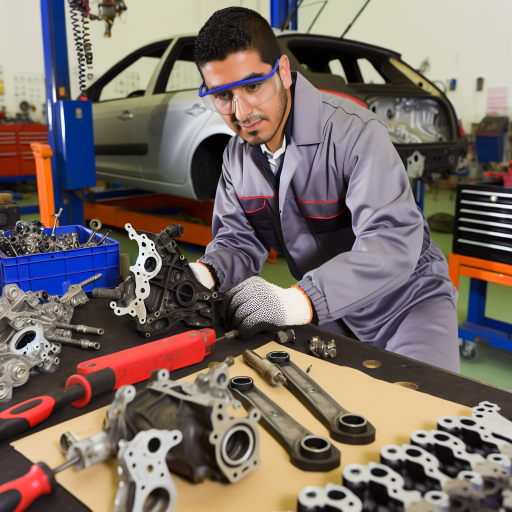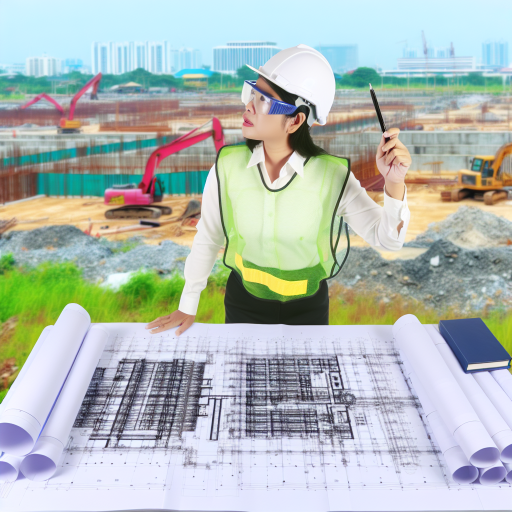Introduction
Machining technology involves shaping raw materials into finished products using various tools and techniques.
Brief overview of machining technology
Machining technology involves shaping raw materials into finished products using various tools and techniques.
Importance of machining technology in various industries
Machining technology is vital in industries such as aerospace, automotive, and manufacturing for producing precision components.
Early Machining Technology
During the early days of machining technology, tools were limited to hand tools and manual techniques.
Workers relied on their craftsmanship and skills to shape materials such as wood, metal, and stone.
These manual techniques required a high level of precision and attention to detail from machinists.
- Hand tools like chisels, files, and drills were commonly used for cutting and shaping materials.
- Machinists would spend hours handcrafting intricate designs and parts for various applications.
- Despite the labor-intensive nature of manual techniques, craftsmen were able to create precise and high-quality products.
Development of Basic Machines
As demand for more efficient machining processes grew, basic machines like lathes and milling machines were developed.
These early machines automated some of the manual processes, allowing for faster and more precise production.
Lathes, for example, allowed machinists to create symmetrical parts by rotating materials against cutting tools.
- Milling machines used rotary cutters to remove material from a workpiece, producing complex shapes and designs.
- These basic machines laid the foundation for the development of more advanced machining tools in the future.
- With the introduction of these machines, machining technology began to evolve rapidly, improving efficiency and quality.
Industrial Revolution and the Impact on Machining Technology
The Industrial Revolution marked a significant turning point in the history of machining technology.
During this period, several key advancements revolutionized the way machines were designed and operated.
Introduction of Steam-Powered Machines
- Steam-powered machines, such as the steam engine, played a crucial role in the Industrial Revolution.
- These machines provided a more efficient source of power, allowing for faster and more precise machining processes.
- The introduction of steam-powered machines enabled the mass production of goods on a scale never seen before.
- With steam power, industries were able to increase their output, leading to a higher demand for machined products.
Mass Production and Standardization of Parts
- One of the most significant impacts of the Industrial Revolution on machining technology was the concept of mass production.
- Mass production allowed for the large-scale manufacturing of identical parts, leading to increased efficiency and lower production costs.
- Standardization of parts became a common practice in industries, ensuring interchangeability and easier assembly of products.
- This standardization also paved the way for the development of new machining techniques and tools to meet the growing demand.
The Industrial Revolution brought about a radical transformation in machining technology.
The introduction of steam-powered machines and mass production techniques revolutionized the way products were manufactured.
This led to increased efficiency and productivity in various industries.
Learn More: Surveyor Skills: Key Competencies for Success
Advancements in machining technology in the 20th century:
Introduction of CNC machines
The 20th century saw a significant leap in machining technology with the introduction of Computer Numerical Control (CNC) machines.
- These machines revolutionized the manufacturing industry by allowing for precise control over machining operations.
- CNC machines replaced traditional manual control systems, leading to increased efficiency and accuracy in production processes.
- Programmable logic controllers (PLCs) enabled CNC machines to perform complex tasks with minimal human intervention.
- The versatility of CNC machines allowed for the production of intricate and customized parts that were previously impossible to manufacture.
Automation and computerization of manufacturing processes
In addition to CNC machines, the 20th century witnessed a shift towards automation and computerization in manufacturing processes.
- Automation technologies such as robots and robotic arms were introduced to handle repetitive tasks in machining operations.
- These automated systems improved production efficiency, reduced lead times, and enhanced overall product quality.
- Computer-aided design (CAD) and computer-aided manufacturing (CAM) software became essential tools in modern machining processes.
- Integration of CAD/CAM software with CNC machines enabled seamless communication and data transfer for streamlined production workflows.
Advancements in machining technology during the 20th century paved the way for a new era of precision engineering and manufacturing excellence.
Find Out More: How to Achieve a Professional Finish with Spray Paint
Transform Your Career Today
Unlock a personalized career strategy that drives real results. Get tailored advice and a roadmap designed just for you.
Start NowRecent Innovations in Machining Technology
In the ever-evolving world of machining technology, recent innovations have significantly transformed the landscape of manufacturing.
These advancements have revolutionized the way products are designed, produced, and distributed.
Additive Manufacturing (3D Printing)
- 3D printing, also known as additive manufacturing, is a groundbreaking technology that allows for the creation of complex parts and prototypes with exceptional accuracy and precision.
- This process involves building objects layer by layer using materials such as plastics, metals, and ceramics, offering endless possibilities in terms of customization and design flexibility.
- 3D printing has gained popularity across various industries, from aerospace and automotive to healthcare and consumer goods, as it enables rapid prototyping, custom production, and cost-effective manufacturing solutions.
- The ability to produce parts on-demand, reduce waste, and optimize supply chains has positioned additive manufacturing as a game-changer in the field of machining technology.
Laser Cutting and Other Precision Machining Techniques
- Laser cutting has emerged as a preferred method for precision cutting, welding, and engraving of materials such as metals, plastics, and composites.
- This non-contact process utilizes a high-powered laser beam to accurately slice through materials with minimal heat-affected zones and superior edge quality.
- Advancements in laser technology have led to increased cutting speeds, improved accuracy, and expanded capabilities for intricate designs and complex geometries.
- Besides laser cutting, other precision machining techniques like waterjet cutting, electrical discharge machining (EDM), and computer numerical control (CNC) machining have also seen significant advancements in recent years.
These recent innovations in machining technology have paved the way for enhanced efficiency, productivity, and quality in manufacturing processes.
As technology continues to evolve, the possibilities for future developments in machining techniques are endless.
This promises a brighter and more innovative future for the industry.
Discover More: How to Choose the Right Fence for Your Property

Throughout history, machining technology has played a vital role in shaping the way products are manufactured in various industries.
With advancements in machining technology, modern industries have experienced a significant impact in terms of efficiency, productivity, and customization capabilities.
Improved Efficiency and Productivity
- Machining technology has revolutionized the way products are produced by streamlining processes and reducing production times.
- Automation and computer numerical control (CNC) have enabled manufacturers to achieve higher precision and accuracy in their operations.
- Efficient cutting tools and machining strategies have led to increased output and reduced waste in manufacturing processes.
- Real-time monitoring and data analytics tools have optimized workflow management, resulting in improved overall efficiency and productivity.
Ability to Manufacture Complex and Customized Parts
- Advancements in machining technology have opened up new possibilities for creating intricate and complex parts that were previously impossible to manufacture.
- 3D printing, additive manufacturing, and multi-axis machining have enabled the production of highly customized components for various industries.
- Computer-aided design (CAD) software allows engineers to design and simulate complex parts before they are manufactured, ensuring precision and accuracy.
- Customization capabilities offered by modern machining technology have empowered industries to meet the diverse needs of customers and markets more effectively.
The evolution of machining technology has had a profound impact on modern industries by enhancing efficiency, productivity, and customization capabilities.
As technology continues to advance, we can expect further innovations that will revolutionize the manufacturing landscape and drive progress in various sectors.
Explore Further: Top 10 Cities for Welders in the USA: Where to Work?
Challenges and Future Prospects of Machining Technology
Skills Gap and Training Issues
The machining industry faces a significant challenge in terms of the skills gap.
Many experienced machinists are reaching retirement age, creating a shortage of skilled workers.
This gap can lead to issues such as decreased productivity and lower-quality output.
To address this challenge, companies need to invest in training programs to develop the next generation of machinists.
Integration of AI and IoT in Machining Processes
The future of machining technology lies in the integration of artificial intelligence (AI) and the Internet of Things (IoT).
AI can optimize machining processes by analyzing vast amounts of data and making real-time adjustments.
IoT enables machines to communicate with each other, leading to improved automation and efficiency.
By combining these technologies, manufacturers can achieve higher levels of precision and productivity.
Future Directions in Machining Technology
The challenges facing the machining industry, such as the skills gap and training issues, require proactive solutions.
Transform Your Career Today
Unlock a personalized career strategy that drives real results. Get tailored advice and a roadmap designed just for you.
Start NowThe integration of AI and IoT presents exciting prospects for the future of machining technology.
By embracing these advancements and investing in workforce development, companies can overcome challenges and thrive in a rapidly evolving industry.
Advancements in Machining Technology
Throughout history, machining technology has undergone significant advancements.
It evolved from primitive tools to modern state-of-the-art equipment.
Individuals and industries must stay updated with the latest trends.
Embracing new technologies can improve efficiency and productivity.
This also enhances overall competitiveness in the global market.
Staying updated ensures professionals in the industry remain relevant.
They will be better equipped to tackle emerging challenges.
As machining technology continues to evolve, it is essential to keep pace.
This can drive future growth and success.
The evolution of machining technology showcases the drive for improvement.
Understanding and adapting to these developments positions businesses for success.
It also promotes sustainability in the industry.
Additional Resources
Toyota Production System | Vision & Philosophy | Company | Toyota …
[E-Books for Sale]
The Big Book of 500 High-Paying Jobs in America: Unlock Your Earning Potential
$19.99 • 500 High-Paying Jobs • 330 pages
Explore 500 high-paying jobs in America and learn how to boost your career, earn more, and achieve success!
See All 500 High-Paying Jobs of this E-Book
1001 Professions Without a Degree: High-Paying American Jobs You Can Start Now
$19.99 • 1001 Professions Without a Degree • 174 pages
Discover 1001 high-paying jobs without a degree! Unlock career tips, skills, and success strategies for just $19.99!




